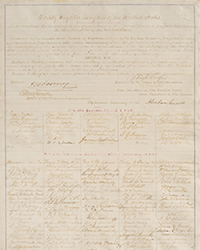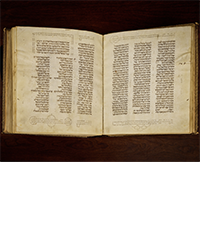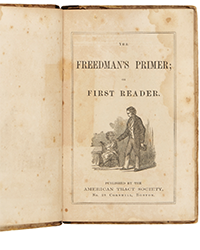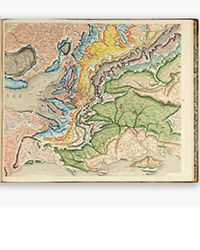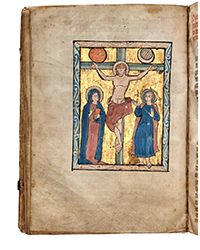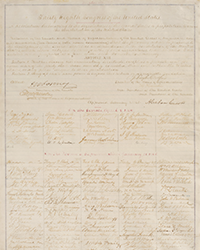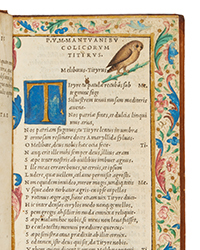L & T Respess Books has issued their List 361 with the subject being Mississippi. This Mississippi is the state, though the River from which it got its name forms the western boundary. Mississippi is located in the Deep South and has much in common with its Dixie neighbors. There is lots of cotton, rural communities, oceanfront property, and issues of race and slavery that have plagued the South. Living wasn't always easy, even in the summertime, but along the way it left its history, and many pieces of that past can be found in this catalogue. Here are a few selections.
This was the ultimate place to visit on the Gulf Coast a century ago. Item 18 is an eight-page brochure for the Buena Vista Hotel in Biloxi, Mississippi, circa 1935, together with four other promotional pieces. It opened its doors on July, 4th, 1924. It was a grand place, U-shaped, with great arches in the front which faced the ocean. It was located on Old Spanish Trail, now Route 90. It was so successful that owners expanded it in 1927. Then came the Depression, and the hotel business was depressing too. But, new ownership saved it, coming up with the idea of making it the place to hold conventions. More expansions added a convention hall that could hold 1,500 people and a large room for dancing. More rooms and a huge swimming pool were added in the 1950s. Then another tragic event knocked her down again – Hurricane Camille in 1969. She survived, but ran through a succession of owners, including famed New Orleans musician Pete Fountain. They couldn't save it. The Buena Vista stood vacant in the 1980s other than storage space for a nearby motel. Then, a fire in 1991 destroyed the broken structure, which was finally demolished in 1993. The site now holds a minor league baseball park. Priced at $65
It was almost 25 years after the Civil War ended that Jefferson Davis wrote to officials in North Carolina reluctantly declining their invitation to celebrate the state's 100th anniversary, on the grounds of ill health. He describes the determination of North Carolina since its early colonial days to hold onto its “unalienable rights.” He describes the state through Colonial to Revolutionary times and then to the War of 1812. It ends with – you guessed it – the Civil War (he refers to it as the War between the States). He concludes by saying that “...the state, having won her independence by heavy sacrifices, had never surrendered it nor attempted to delegate the unalienable rights of the people.” To the end, he argued for the justice of the “Lost Cause.” This broadside features a portrait of Davis and, in color, Confederate flags. It's heading begins, Ex-President Davis' Last Paper of a Public Nature, Written from a Sick Bed Five Weeks before His Death. Item 47. $450.
Were it not for his role as leader of a rebellion against the United States, Jefferson Davis might best be remembered for initiating the army's “camel corps” while he was Secretary of War, before the South seceded. He was no more successful in this endeavor than in the later one, though that was no fault of the camels. They did their job well. The plan was to import camels to take the place of pack mules and some tasks of horses in the desert Southwest, where conditions are much like northern Africa. Two groups were purchased from Africa and the Middle East, and after netting out deaths and births at sea, about 70 of them made it to America. They were given good care and quarters at sea, ironic considering the brutal conditions under which human slaves were transported to the Americas. In 1856, the camels were put to the test – carrying supplies through the hot dry desert from Texas to California to survey a wagon road. They passed with flying colors, carrying heavy burdens mules could not manage and surviving the journey better than mules or horses. In California, they were tried on mail routes but not so successful. They were well-suited for hauling heavy loads, but speed was not their forte. The next Secretary of State was so impressed he ordered the purchase of 1,000 more in 1859. That order was never filled, and here perhaps Davis was partly responsible for the failure of his plan. With tensions North and South rising, breaking out in war a short time later, Congress was preoccupied. During the war, half the camels were captured by the Confederate army, and the other half languished in Los Angeles with no work. The Confederates used them successfully, but their soldiers “rebelled.” As with most animals, you have to understand their personalities to use them effectively. On both sides, they fell into the hands of untrained handlers. Meanwhile, they have a strong odor that most humans find unpleasant. Army commanders who didn't understand their accomplishments decided to sell them. Those in Los Angeles were sold, primarily to circuses, and those recaptured from the Confederates were sold after the war. Some were let loose, and camels were spotted roaming the the Texas desert as late as the 1930s. Walter L. Fleming wrote an account of the experiment for the February 1909 issue of Popular Science entitled Jefferson Davis' Camel Experiment. This is the first separate printing of this article, issued by the Louisiana State University Bulletin. Item 49. $125.
Henry S. Foote was one of the South's more colorful politicians. He served as a senator from and Governor of Mississippi in the late 1840s-1850s. A short, bald man, Foote made up for his slight stature with a large mouth. At some point or other, he managed to offend just about everyone, north and south (perhaps being the one thing they could agree on). Early in his senate career, he pushed what became the Compromise of 1850, but after that, he was less than a peacemaker. He so insulted Senator Thomas Hart Benton that the latter came after him in the senate. Foote pulled his revolver, while Benton dared him to shoot. He didn't. One thing about Foote was he was a fervent unionist, though not an abolitionist, in a secession-minded South. He figured he would do better politically in California and moved, but after being unsuccessful in securing a nomination, he returned, though then moving on to Tennessee. When Tennessee seceded, it was no longer wise to oppose the Confederacy, becoming a representative in the Confederate Congress. He was a thorn in Jefferson Davis' side and attacked his Secretary of State, Judah Benjamin, with anti-Semitic slurs. Late in the war, he went to the North hoping to meet Lincoln but was arrested trying to cross the border. The Confederate Congress censured Foote, whereupon he went to Nevada to stay with his brother-in-law. U.S. authorities gave him a choice to leave the country or go back to the South. He went to England. Meanwhile, he was expelled from the Confederate Congress. After the war, he returned to America but was no longer a political force, though in 1878, President Rutherford Hayes did appoint him Superintendent of the Mint in New Orleans, a position he held until his death in 1880. Item 55 is a large autograph by the colorful Mr. Foote – H. S. Foote. Now that you know his story, you may find it a little more interesting. $50.
Southerners aren't generally known for being progressives, but evidently their pecans are. Item 9 is a four-page foldout by by Col. W. R. Stuart published in 1891, Progressive Pecan Culture: The Good Points of a New Industry Ably Set Forth, of Great Interest to Southern Cultivators. Pecans are a big enough business in Mississippi today to support a Mississippi Pecan Growers Association, which tells us pecans are the only native American nut and that 80% of the world's pecans are grown in the southern states of America. The Mississippi State University Extension adds that southern Mississippi today is the “epicenter” of modern pecan production. $65.
L & T Respess Books may be reached at 413-727-3435 or respessbooks@cstone.net.


